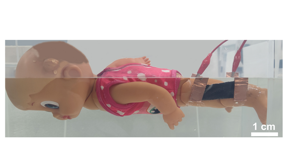Home > Press > Underwater movement sensor alerts when a swimmer might be drowning
 |
| An underwater movement sensor attached to a motorized swimming dolls knee alerts a smartphone app when the doll stops kicking, simulating a swimmer in distress.
CREDIT Adapted from ACS Nano 2022, DOI: 10.1021/acsnano.2c08325 |
Abstract:
Many flexible fitness trackers cant be submerged in water because the coatings required to completely seal these devices would make them uncomfortable to wear. Now, researchers reporting in ACS Nano have applied a thin, slippery coating to conductive fabric, creating a breathable underwater movement sensor. They integrated the sensor into a smart device that wirelessly alerts a smartphone app when a swimmer stops moving, an indication that they could be drowning.
Underwater movement sensor alerts when a swimmer might be drowning
Washington, DC | Posted on October 7th, 2022
Underwater movement sensors could have many applications, such as monitoring heart rate and tracking swimmers activity and safety. However, current methods to protect these electronics make the devices thick and impermeable to air, which could lead to skin irritation. Previous research, though, has shown that thin, even layers of polydimethylsiloxane (PDMS) provide enough water repulsion to protect flexible movement sensors underwater, but its unclear whether the coating would be comfortable. So, Jianying Huang, Cheolmin Park, Yuekun Lai and colleagues wanted to test PDMS as a water-repellent coating for a fabric-based sensor that would be part of a wireless underwater movement detection system.
To do this, the researchers dipped a piece of polyester knit fabric into a graphene oxide solution and then into hydroiodic acid. The last immersion was into a solution containing PDMS microparticles and nanoparticles. Initial tests showed that the coated fabric was conductive and water-repellent, yet still permeable to air, suggesting that the material would be comfortable to wear. When a sample of the coated fabric was attached to a persons finger that was then bent while underwater, it produced a measurable electrical response.
The team combined the fabric-based sensor with a power supply and a data collector to create a smart underwater movement system that could wirelessly transmit the electrical response to a smartphone app. When the smart device was attached to a motorized swimming doll, the app tracked the dolls kicking legs. To simulate a swimmer in distress, the dolls kicking motion was turned off, and the app sent a red warning message. The researchers say that because the smart movement sensor repels water, it could help monitor swimmers safety and be used in other types of underwater sensors.
The authors acknowledge funding from the National Natural Science Foundation of China, the Natural Science Funds for Distinguished Young Scholars of Fujian Province, the Natural Science Foundation of Fujian Province, the 111 Project, the China National Textile and Apparel Council Key Laboratory of Flexible Devices for Intelligent Textile and Apparel, Soochow University, the State Key Laboratory of New Textile Materials and Advanced Processing Technologies, and the Creative Materials Discovery Program through the National Research Foundation of Korea (NRF).
####
About American Chemical Society
The American Chemical Society (ACS) is a nonprofit organization chartered by the U.S. Congress. ACS mission is to advance the broader chemistry enterprise and its practitioners for the benefit of Earth and all its people. The Society is a global leader in promoting excellence in science education and providing access to chemistry-related information and research through its multiple research solutions, peer-reviewed journals, scientific conferences, eBooks and weekly news periodical Chemical & Engineering News. ACS journals are among the most cited, most trusted and most read within the scientific literature; however, ACS itself does not conduct chemical research. As a leader in scientific information solutions, its CAS division partners with global innovators to accelerate breakthroughs by curating, connecting and analyzing the worlds scientific knowledge. ACS main offices are in Washington, D.C., and Columbus, Ohio.
To automatically receive news releases from the American Chemical Society, contact
Follow us: Twitter | Facebook | LinkedIn | Instagram
For more information, please click here
Contacts:
ACS Newsroom
American Chemical Society
Katie Cottingham
American Chemical Society
Office: 202-236-5115
Copyright © American Chemical Society
If you have a comment, please Contact us.
Issuers of news releases, not 7th Wave, Inc. or Nanotechnology Now, are solely responsible for the accuracy of the content.
News and information
![]()
Disposable electronics on a simple sheet of paper October 7th, 2022
![]()
Taking salt out of the water equation October 7th, 2022
Wearable electronics
![]()
Disposable electronics on a simple sheet of paper October 7th, 2022
Govt.-Legislation/Regulation/Funding/Policy
![]()
NISTs superconducting hardware could scale up brain-inspired computing October 7th, 2022
![]()
Disposable electronics on a simple sheet of paper October 7th, 2022
Possible Futures
![]()
NISTs superconducting hardware could scale up brain-inspired computing October 7th, 2022
Discoveries
![]()
Disposable electronics on a simple sheet of paper October 7th, 2022
![]()
Taking salt out of the water equation October 7th, 2022
Announcements
![]()
Disposable electronics on a simple sheet of paper October 7th, 2022
![]()
Taking salt out of the water equation October 7th, 2022
Interviews/Book Reviews/Essays/Reports/Podcasts/Journals/White papers/Posters
![]()
Disposable electronics on a simple sheet of paper October 7th, 2022
![]()
Taking salt out of the water equation October 7th, 2022
Safety-Nanoparticles/Risk management
![]()
New protocol for assessing the safety of nanomaterials July 1st, 2022
![]()
Nylon cooking bags, plastic-lined cups can release nanoparticles into liquids April 22nd, 2022
![]()
No nanoparticle risks to humans found in field tests of spray sunscreens December 2nd, 2020
Grants/Sponsored Research/Awards/Scholarships/Gifts/Contests/Honors/Records
![]()
Drawing data in nanometer scale September 30th, 2022
![]()
Multi-institution, $4.6 million NSF grant to fund nanotechnology training September 9th, 2022
![]()
Understanding outsize role of nanopores: New research reveals differences in pH, and more, about these previously mysterious environments August 26th, 2022










